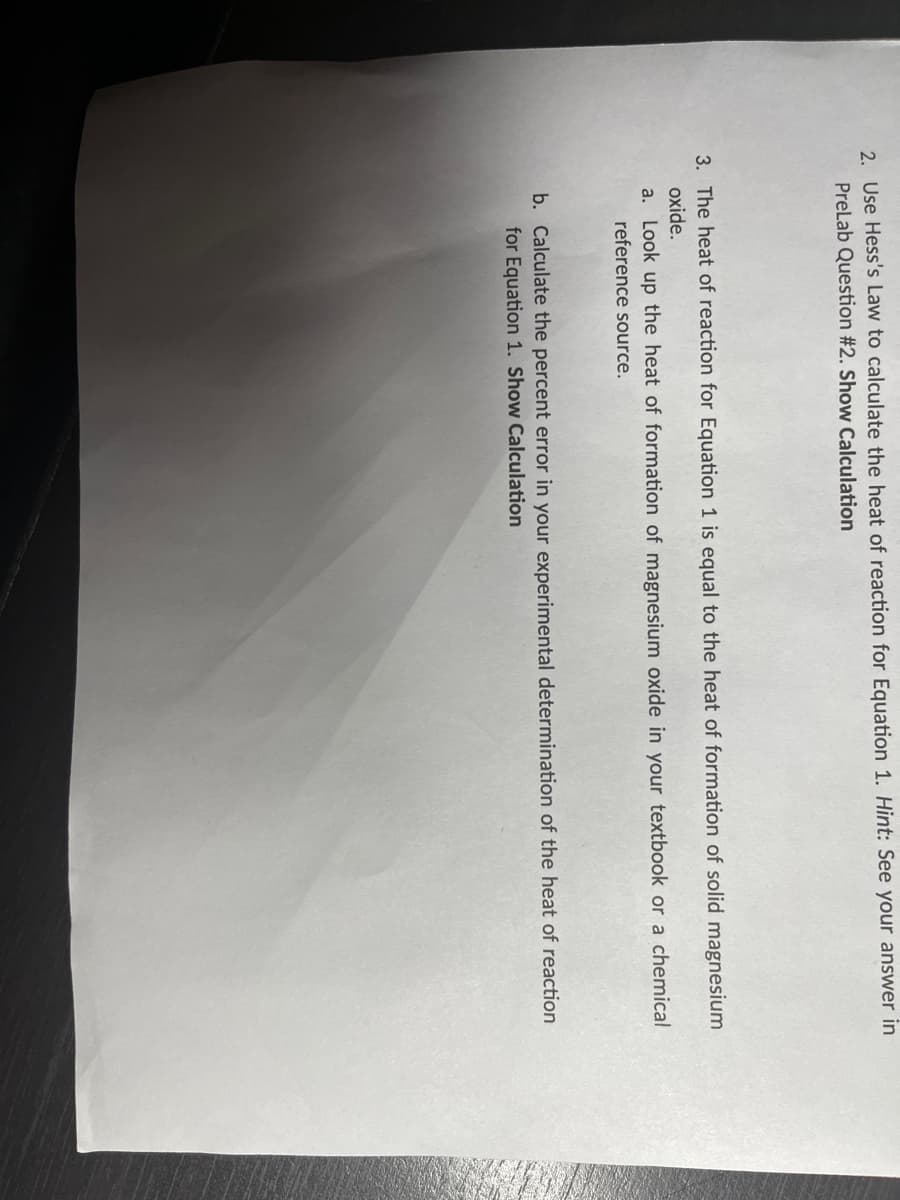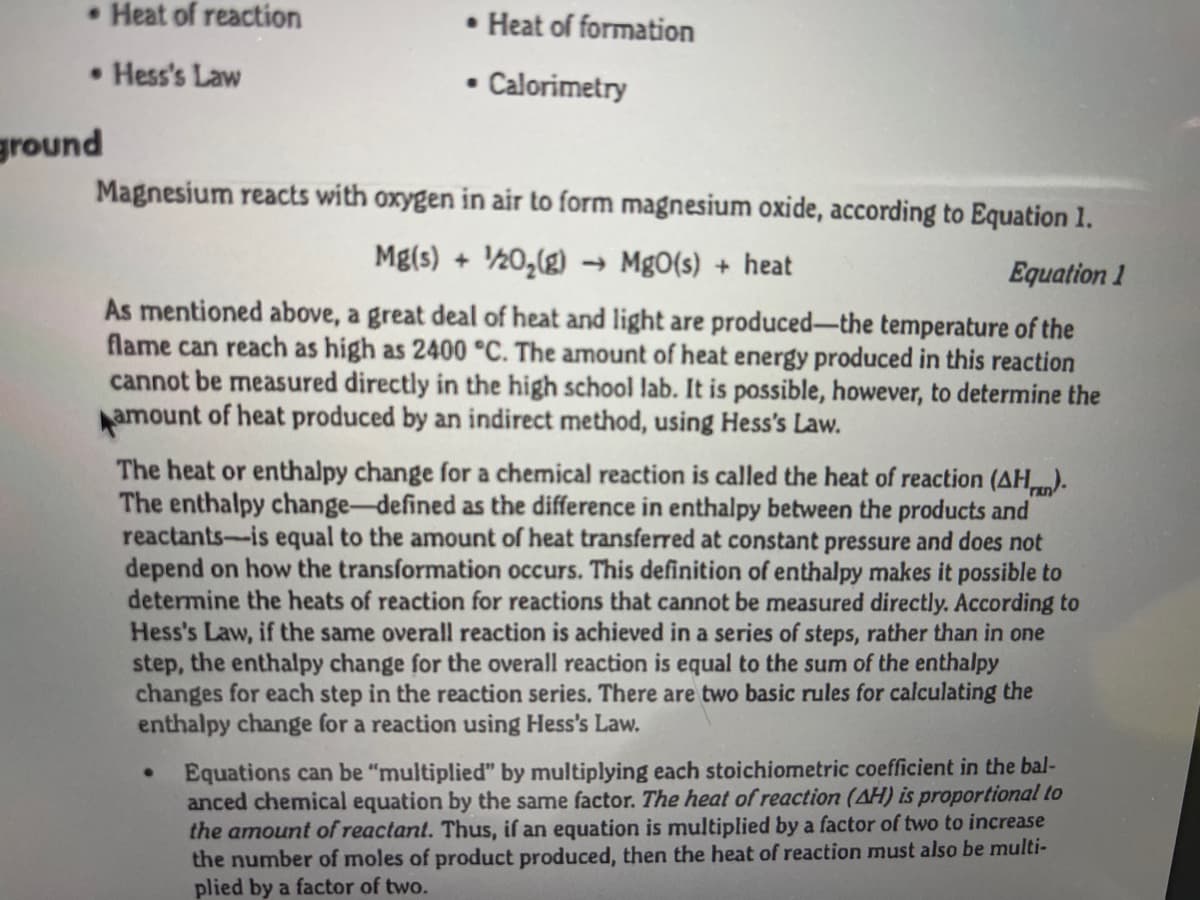Introductory Chemistry: A Foundation
9th Edition
ISBN:9781337399425
Author:Steven S. Zumdahl, Donald J. DeCoste
Publisher:Steven S. Zumdahl, Donald J. DeCoste
Chapter10: Energy
Section: Chapter Questions
Problem 81AP
Related questions
Question
Answer question 3

Transcribed Image Text:2. Use Hess's Law to calculate the heat of reaction for Equation 1. Hint: See your answer in
PreLab Question #2. Show Calculation
3. The heat of reaction for Equation 1 is equal to the heat of formation of solid magnesium
oxide.
a. Look up the heat of formation of magnesium oxide in your textbook or a chemical
reference source.
b. Calculate the percent error in your experimental determination of the heat of reaction
for Equation 1. Show Calculation

Transcribed Image Text:• Heat of reaction
• Heat of formation
• Hess's Law
• Calorimetry
ground
Magnesium reacts with oxygen in air to form magnesium oxide, according to Equation 1.
Mg(s) + ½0,lg)
- MgO(s) + heat
Equation 1
As mentioned above, a great deal of heat and light are produced-the temperature of the
flame can reach as high as 2400 °C. The amount of heat energy produced in this reaction
cannot be measured directly in the high school lab. It is possible, however, to determine the
amount of heat produced by an indirect method, using Hess's Law.
The heat or enthalpy change for a chemical reaction is called the heat of reaction (AH).
The enthalpy change-defined as the difference in enthalpy between the products and
reactants-is equal to the amount of heat transferred at constant pressure and does not
depend on how the transformation occurs. This definition of enthalpy makes it possible to
determine the heats of reaction for reactions that cannot be measured directly. According to
Hess's Law, if the same overall reaction is achieved in a series of steps, rather than in one
step, the enthalpy change for the overall reaction is equal to the sum of the enthalpy
changes for each step in the reaction series. There are two basic rules for calculating the
enthalpy change for a reaction using Hess's Law.
Equations can be "multiplied" by multiplying each stoichiometric coefficient in the bal-
anced chemical equation by the same factor. The heat of reaction (AH) is proportional to
the amount of reactant. Thus, if an equation is multiplied by a factor of two to increase
the number of moles of product produced, then the heat of reaction must also be multi-
plied by a factor of two.
Expert Solution
This question has been solved!
Explore an expertly crafted, step-by-step solution for a thorough understanding of key concepts.
Step by step
Solved in 2 steps with 2 images

Knowledge Booster
Learn more about
Need a deep-dive on the concept behind this application? Look no further. Learn more about this topic, chemistry and related others by exploring similar questions and additional content below.Recommended textbooks for you

Introductory Chemistry: A Foundation
Chemistry
ISBN:
9781337399425
Author:
Steven S. Zumdahl, Donald J. DeCoste
Publisher:
Cengage Learning

World of Chemistry, 3rd edition
Chemistry
ISBN:
9781133109655
Author:
Steven S. Zumdahl, Susan L. Zumdahl, Donald J. DeCoste
Publisher:
Brooks / Cole / Cengage Learning

Chemistry
Chemistry
ISBN:
9781305957404
Author:
Steven S. Zumdahl, Susan A. Zumdahl, Donald J. DeCoste
Publisher:
Cengage Learning

Introductory Chemistry: A Foundation
Chemistry
ISBN:
9781337399425
Author:
Steven S. Zumdahl, Donald J. DeCoste
Publisher:
Cengage Learning

World of Chemistry, 3rd edition
Chemistry
ISBN:
9781133109655
Author:
Steven S. Zumdahl, Susan L. Zumdahl, Donald J. DeCoste
Publisher:
Brooks / Cole / Cengage Learning

Chemistry
Chemistry
ISBN:
9781305957404
Author:
Steven S. Zumdahl, Susan A. Zumdahl, Donald J. DeCoste
Publisher:
Cengage Learning


Chemistry: An Atoms First Approach
Chemistry
ISBN:
9781305079243
Author:
Steven S. Zumdahl, Susan A. Zumdahl
Publisher:
Cengage Learning

World of Chemistry
Chemistry
ISBN:
9780618562763
Author:
Steven S. Zumdahl
Publisher:
Houghton Mifflin College Div